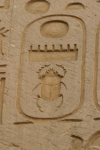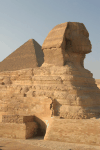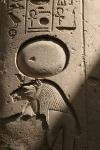A lot of the information on this page is from The Ancient Egypt Site (AES below), the site Ancient Egypt (AE below), and from Wikipedia. These sites have a lot of information and consistent time lines, although they differ. All the hieroglyphic names are from the AE website. The times are from Wikipedia.
From the Third Intermediate Period of Egypt entry in Wikipedia:
The Third Intermediate Period of ancient Egypt began with the death of Pharaoh Ramesses XI in 1077 BCE, which ended the New Kingdom, and was eventually followed by the Late Period. Various points are offered as the beginning for the latter era, though it is most often regarded as dating from the foundation of the 26th Dynasty by Psamtik I in 664 BCE, following the departure of the Nubian Kushite rulers of the 25th Dynasty by the Assyrians under King Assurbanipal. The concept of a "Third Intermediate Period" was coined in 1978 by British Egyptologist Kenneth Kitchen.
The period was one of decline and political instability, coinciding with the Late Bronze Age collapse of civilizations in the ancient Near East and Eastern Mediterranean (including the Greek Dark Ages). It was marked by division of the state for much of the period and conquest and rule by non-native Egyptians.
The period of the 21st Dynasty is characterized by the country's fracturing kingship. Already during Ramesses XI's reign, the 20th Dynasty of Egypt was losing its grip on the city of Thebes, whose priests were becoming increasingly powerful. After his death, his successor, Smendes I, ruled from the city of Tanis, but was mostly active only in Lower Egypt, which he controlled. Meanwhile, the High Priests of Amun at Thebes ruled Middle and Upper Egypt in all but name. However, this division was less significant than it seems, since both the priests and pharaohs came from the same family.
The country was firmly reunited by the 22nd Dynasty founded by Shoshenq I in 945 BCE (or 943 BCE), who descended from Meshwesh immigrants, originally from ancient Libya. This brought stability to the country for well over a century, but after the reign of Osorkon II, particularly, the country had effectively split into two states, with Shoshenq III of the 22nd Dynasty controlling Lower Egypt by 818 BCE while Takelot II and his son Osorkon (the future Osorkon III) ruled Middle and Upper Egypt. In Thebes, a civil war engulfed the city, pitting the forces of Pedubast I, who had proclaimed himself pharaoh, against the existing line of Takelot II/Osorkon B. The two factions squabbled continuously and the conflict was only resolved in Year 39 of Shoshenq III when Osorkon B comprehensively defeated his enemies. He proceeded to found the Upper Egyptian Libyan 23rd Dynasty of Osorkon III – Takelot III – Rudamun, but this kingdom quickly fragmented after Rudamun's death, with the rise of local city states under kings such as Peftjaubast of Herakleopolis, Nimlot of Hermopolis, and Ini at Thebes.
The Nubian kingdom to the south took full advantage of this division and the ensuing political instability. Prior to Piye's Year 20 campaign into Egypt, the previous Nubian ruler – Kashta – had already extended his kingdom's influence into Thebes when he compelled Shepenupet, the serving Divine Adoratice of Amun and Takelot III's sister, to adopt his own daughter Amenirdis, to be her successor. Then, 20 years later, around 732 BCE his successor, Piye, marched north and defeated the combined might of several native Egyptian rulers: Peftjaubast, Osorkon IV of Tanis, Iuput II of Leontopolis and Tefnakht of Sais.
Piye established the 25th Dynasty and appointed the defeated rulers as his provincial governors. He was succeeded first by his brother, Shabaka, and then by his two sons Shebitku and Taharqa. The reunited Nile valley empire of the 25th Dynasty was as large as it had been since the New Kingdom. Pharaohs of the dynasty, among them Taharqa, built or restored temples and monuments throughout the Nile valley, including at Memphis, Karnak, Kawa, and Jebel Barkal. The 25th Dynasty ended with its rulers retreating to their spiritual homeland at Napata. It was there (at El-Kurru and Nuri) that all 25th Dynasty pharaohs were buried under the first pyramids to be constructed in the Nile valley in hundreds of years. The Napatan dynasty led to the Kingdom of Kush, which flourished in Napata and Meroe until at least the 2nd century CE.
The international prestige of Egypt had declined considerably by this time. The country's international allies had fallen firmly into the sphere of influence of Assyria and from about 700 BCE the question became when, not if, there would be war between the two states as Esarhaddon had realised that a conquest of Lower Egypt was necessary to protect Assyrian interests in the Levant.
Despite Egypt's size and wealth, Assyria had a greater supply of timber, while Egypt had a chronic shortage, allowing Assyria to produce more charcoal needed for iron-smelting and thus giving Assyria a greater supply of iron weaponry. This disparity became critical during the Assyrian invasions of Egypt over the period 670–663 BCE. Consequently, pharaoh Taharqa's reign, and that of his successor Tantamani, were filled with constant conflict with the Assyrians. In 664 BCE the Assyrians delivered a mortal blow, sacking Thebes and Memphis. Following these events, and starting with Atlanersa, no Kushite ruler would ever rule over Egypt again.
Upper Egypt remained for a time under the rule of Taharqa and Tantamani, whilst Lower Egypt was ruled from 664 BCE by the nascent 26th Dynasty, client kings established by the Assyrians. In 663 BCE, Tantamani launched a full-scale invasion of Lower Egypt, taking Memphis in April of this year, killing Necho I of Sais in the process as Necho had remained loyal to Ashurbanipal. Tantamani barely had the time to receive the submission of some Delta kinglets and expel the remaining Assyrians that a large army led by Ashurbanipal and Necho's son Psamtik I came back. Tantamani was defeated north of Memphis and Thebes was thoroughly sacked shortly after. The Kushite king withdrew to Nubia while the Assyrian influence in Upper Egypt quickly waned. Permanently weakened by the sack, Thebes peacefully submitted itself to Psamtik's fleet in 656 BCE. To affirm his authority, Psamtik placed his daughter in position to be the future Divine Adoratrice of Amun, thereby also submitting the priesthood of Amun and effectively uniting Egypt. Tantamani's successor Atlanersa was in no position to attempt a reconquest of Egypt as Psamtik also secured the southern border at Elephantine and may even have sent a military campaign to Napata. Concurrently, Psamtik managed to free himself from the Assyrian vassalage while remaining on good terms with Ashurbanipal, possibly owing to an ongoing rebellion in Babylon. By doing so, he brought increased stability to the country during his 54-year reign from the city of Sais.
Four successive Saite kings continued guiding Egypt into another period of peace and prosperity from 610 to 525 BCE. Unfortunately for this dynasty, a new power was growing in the Near East – the Achaemenid Empire of Persia. Pharaoh Psamtik III had succeeded his father Ahmose II for only 6 months before he had to face the Persian Empire at Pelusium. The Persians had already taken Babylon and Egypt was no match for them. Psamtik III was defeated and briefly escaped to Memphis, before he was ultimately imprisoned and, later, executed at Susa, the capital of the Persian king Cambyses, who now assumed the formal title of Pharaoh.
Following is the list of Egyptian Pharaohs as well as I could determine it:
All pictures are © Dr. Günther Eichhorn, unless otherwise noted.
| Name of Pharaoh | Dates | Birth Name | Coronation Name | Horus Name | Comment |
|---|---|---|---|---|---|
| (from The Ancient Egypt Site and Ancient Egypt) | |||||
Third Intermediate Period (Wiki ) | 1077 - 656 BCE | ||||
21st Dynasty (AES Wiki AE) | 1077 - 945 BCE | ||||
Northern Kings (Wiki AE) | 10777 - 943 BCE | ||||
| Smendes I (Wiki) | 1077 - 1051 BCE | n/a | |||
| Amunemose (Wiki) | 1051 - 1047 BCE | n/a | |||
| Pinedjem I (co-regent) (Wiki) | 1062 - 1039 BCE | n/a | |||
| Psusennes I (Pasebakhaienniut I) (Wiki) | 1047 - 1001 BCE | n/a | |||
| Amunemopet (Wiki) | 1001 - 992 BCE | n/a | |||
| Osokhor (Osorkhon the Elder) (Wiki) | 992 - 986 BCE | n/a | |||
| Siamun (Wiki) | 986 - 967 BCE | n/a | |||
| Psusennes II (Pasebakhaenniut II) (Wiki) | 967 - 943 BCE | n/a | |||
High Priests of Amun at Thebes (Wiki AE) | 1080 - 775 BCE | ||||
| Herihor (Wiki) | 1080 - 1074 BCE | n/a | |||
| Piankh (Wiki) | 1074 - 1070 BCE | n/a | n/a | ||
| Pinedjem I (Wiki) | 1070 - 1032 BCE | n/a | |||
| Masaherta (Wiki) | 1054 - 1046 BCE | n/a | n/a | ||
| Djedkhonsuefankh (Wiki) | 1046 - 1045 BCE | n/a | n/a | n/a | |
| Menkheperre (Wiki) | 1045 - 992 BCE | n/a | |||
| Smendes II (Wiki) | 992 - 990 BCE | n/a | n/a | ||
| Pinedjem II (Wiki) | 990 - 976 BCE | n/a | n/a | ||
| Psusennes III (Pasebakhaienniut III) (Wiki) | 976 - 943 BCE | n/a | |||
| Iuput (Wiki) | 944 - 924 BCE | n/a | |||
| Shoshenq II (Wiki) | 924 - 894 BCE | n/a | n/a | ||
| Iuwlot (Wiki) | 894 - 884 BCE | n/a | n/a | ||
| Smendes III (Wiki) | 884 - 874 BCE | n/a | n/a | ||
| Harsiese I (Wiki) | 874 - 860 BCE | n/a | |||
| ///dju/// | 860 - 855 BCE | n/a | n/a | n/a | |
| Nimlot II (Wiki) | 855 - 845 BCE | n/a | n/a | ||
| Takelot F (Wiki) | 845 - 840 BCE | n/a | |||
| Osorkon B (Wiki) | 840 - 785 BCE | n/a | n/a | ||
| Harsiese II (Wiki) | 835 - 800 BCE | n/a | n/a | ||
| Takelot II (Wiki) | 800 - 775 BCE | n/a | n/a | ||
22nd Dynasty (Libyans) (AES Wiki AE) | 943 - 716 BCE | ||||
| Shoshenq I (Wiki) | 943 - 922 BCE | n/a | |||
| Osorkon I (Wiki) | 922 - 887 BCE | n/a | |||
| Shoshenq II (Wiki) | 887 - 885 BCE | n/a | |||
| Takelot I (Wiki) | 885 - 872 BCE | n/a | |||
| Osorkon II (Wiki) | 872 - 837 BCE | n/a | |||
| Harsiese I (Wiki) | 870 - 860 BCE | n/a | |||
| Shoshenq III (Wiki) | 837 - 798 BCE | n/a | |||
| Shoshenq IV (Wiki) | 798 - 785 BCE | n/a | n/a | n/a | |
| Pami (Pimai) (Wiki) | 785 - 778 BCE | n/a | |||
| Shoshenq V (Wiki) | 778 - 740 BCE | n/a | |||
| PedubastII (Wiki) | 740 - 730 BCE | n/a | n/a | n/a | |
| Osorkon IV | 730 - 716 BCE | n/a | |||
23rd Dynasty (Libyans) (AES Wiki AE) | 880 - 720 BCE | ||||
| Takelot II (Wiki) | 840 - 815 BCE | n/a | |||
| Petubastis I (Wiki) | 829 - 804 BCE | n/a | |||
| Iuput I (Wiki) | 816 - 804 BCE | n/a | n/a | n/a | Co-regent with Petubastis I |
| Shoshenq VI (Wiki) | 804 - 798 BCE | n/a | |||
| Osorkon III (Wiki) | 798 - 769 BCE | n/a | |||
| Takelot III (Wiki) | 774 - 759 BCE | n/a | |||
| Rudamun (Wiki) | 759 - 755 BCE | n/a | |||
| Shoshenq VII (Wiki) | 755 - 732 BCE | n/a | n/a | n/a | |
| Ini (Wiki) | 720 - 715 BCE | n/a | |||
| Payeftjawembastet (Wiki) | n/a | ||||
| Nimlot III | 754 - 725 BCE | n/a | n/a | ||
| Djehutiemhat | 728 BCE | n/a | |||
24th Dynasty (AES Wiki AE) | 732 - 720 BCE | ||||
| Tefnakhte (Wiki) | 732 - 725 BCE | n/a | |||
| Bakara (Bakenranef) (Wiki) | 725 - 720 BCE | n/a | |||
25th Dynasty (AES Wiki AE) | 770 - 656 BCE | ||||
| Alare (Wiki) | 770 - 760 BCE | n/a | n/a | ||
| Kashta (Wiki) | 760 - 747 BCE | n/a | |||
| Piye (Piankhi) (Wiki) | 747 - 714 BCE | ||||
| Shebitku (Wiki) | 714 - 705 BCE | n/a | |||
| Shabaka (Wiki) | 705 - 690 BCE | ||||
| Taharqa (Wiki) | 690 - 664 BCE | ||||
| Tanutamun (Wiki) | 664 - 656 BCE | ||||
|
|
|
Late Dynastic Period
|

This page contains 1 picture
Here are the links to the other pages on Egypt:






Page last updated on Tue Nov 2 17:23:25 2021 (Mountain Standard Time)
Page last updated on Tue Apr 23 22:35:40 2024 (Mountain Standard Time)
Egypt - Pharaohs of the Third Intermediate Period - 1070 - 656 BCE on soaring.guenther-eichhorn.com